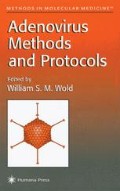Abstract
Adenoviruses encode a cysteme endopeptidase synthesized late in virus infection which is essential for virlon maturation and infectivity (1,2). The enzyme 1s encapsidated (approx 20 molecules per vinon) and may also have a role during decapsidation (3–5). Although there are approx 100 adenovirus serotypes known to infect vertebrates, so far only the human adenovirus type 2 (Ad2) enzyme has been studied. The recombinant protein expressed in Escherichia coli and insect cells has been purified and characterized (3,6–8). The enzyme is a 204-residue monomer of 24,838 Dalton with a pI of 10.59 and optimal activity at 45°C and pH 8.0. The recombinant enzyme is stimulated by an 11-amino acid cleavage fragment from viral protein pre-VI. GVQSLKRRRCF. The peptide is presumed to regulate enzyme activity in vivo during virus infection. It is bound to C104 on the enzyme via a disulphide bridge (9). Mutational analysis and X-ray chrystallography identified the active-site triad as H54-C122-E71 (8–11). The substrate specificity of the enzyme is (M,I,L)XGG-X or (M,I,L)XGX-G (12). Alkylating agents and E64 inhibit the protease and virus infection as expected (13). Specific inhibitors are not yet available. To date, 17 protease genes have been sequenced in different virus serotypes. The translated amino acid sequences range from 201 to 214 residues and show both variable and highly conserved regions (1,11).
Access this chapter
Tax calculation will be finalised at checkout
Purchases are for personal use only
References
Weber, J. M. (1995) The adenovirus endopeptidase and its role in virus infection, in Molecular Repertoire of Adenoviruses (Doerfler, W. and Petra Bohm, P, eds), Curr Topics Microbiol Immunol. 199/I pp.227–235
Weber, J. M. and Tihanyi, K. (1994) Adenoviruses endopeptidases Methods Enzymol 244D, 595–604.
Anderson, C. W. (1990) The protemase polypeptide of adenovirus serotype 2 virtons. Virology 177, 259–272.
Cotten, M. and Weber, J. M. (1995) The adenovirus protease is required for virus entry into host cells. Virology 213, 494–502
Greber, U. F., Webster, P., Weber, J., and Helenius, A. (1996) The role of the adenovirus protease in virus entry into cells EMBO J 15, 1766–1777.
Houde, A. and Weber, J. M. (1990) Adenovirus protemases’ comparison of amino acid sequences and expression of the cloned cDNA in Escherichia coli. Gene 88, 269–273
Tihanyl, K., Bourbonniere, M., Houde, A., Rancourt, C., and Weber, J. M. (1993) Isolation and properties of the adenovirus type 2 protemase J Biol Chem 268, 1780–1785
Webster, A., Hay, R. T., and Kemp, G (1993) The adenovirus protease is activated by a virus-coded disulphide-linked peptide. Cell 72, 97–104
Ding, J., McGrath, W. J., Sweet, R. M., and Mangel, W. F. (1996) Crystal structure of the human adenovirus protenase with its 11 ammo acid cofactor. EMBO J 15, 1778–1783.
Grierson, A. W., Nicholson, R., Talbot, P., Webster, A., and Kemp, G. (1994) The protease of adenovirus serotype 2 requires cysteine residues for both activation and catalysis. J. Gen. Virol. 75, 2761–2764.
Rancourt, C., Tihanyi, K., Bourbonniere, M., and Weber, J. M. (1994) Identification of active-site residues of the adenovirus endopeptidase Proc Natl Acad Sci. USA 91, 844–847
Webster, A., Russell, W. C, and Kemp, G. D. (1989) Characterization of the adenovirus protemase, substrate specificity J Gen Virol 70, 3215–3223
Sircar, S., Keyvani-Amineh, H., and Weber, J. M. (1996) Inhibition of adenovirus infection with protease inhibitors. Antiviral Res 30, 147–153
Mangel, W. F., McGrath, W. J., Toledo, D L., and Anderson, C. W. (1993) Viral DNA and a viral peptide can act as cofactors of adenovirus virton protemase activity. Nature 361, 274,275
Diouri, M., Geoghegan, K. F, and Weber, J. M. (1995) Functional characterization of the adenovirus proteinase using fluorogenic substrates. Protein Peptide Lett 6, 363–370.
Mangel, W. F., Toledo, D. L., Brown, M. T., Martin, J. H., and McGrath, W. J. (1996) Characterization of three components of human Adenovirus proteinase activity in vitro. J Biol Chem 271, 536–543.
Author information
Authors and Affiliations
Editor information
Editors and Affiliations
Rights and permissions
Copyright information
© 1999 Humana Press Inc., Totowa, NJ
About this protocol
Cite this protocol
Weber, J.M. (1999). Adenovirus Protease. In: Wold, W.S.M. (eds) Adenovirus Methods and Protocols. Methods in Molecular Medicine™, vol 21. Springer, Totowa, NJ. https://doi.org/10.1385/0-89603-551-4:277
Download citation
DOI: https://doi.org/10.1385/0-89603-551-4:277
Publisher Name: Springer, Totowa, NJ
Print ISBN: 978-0-89603-551-5
Online ISBN: 978-1-59259-603-4
eBook Packages: Springer Protocols

